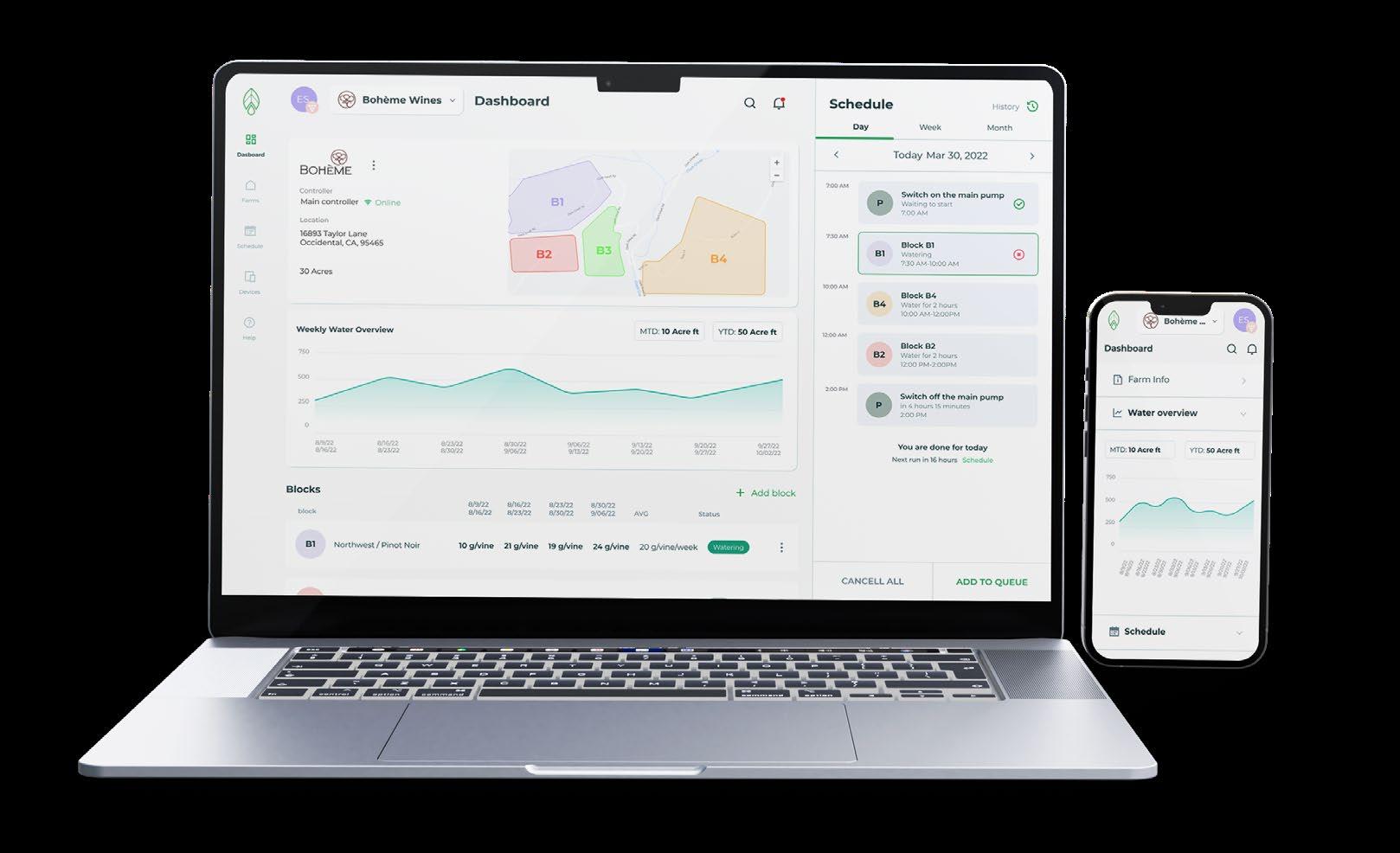
8 minute read
Agrinoze develops system for automated, precision irrigation
Smart irrigation technology:
Less water, less cost
Advertisement
We caught up with Devon Wright, CEO at Lumo, to find out more about their smart irrigation technology that saves water, improves crop quality and reduces costs.
Irrigation is the largest user of freshwater globally. This also makes it one of the largest energy users, and one of the largest employers. So anything that challenges water availability has a disproportionate impact on water, energy and labor costs for our growers.
A changing climate is shifting rain patterns and increasing drought intensity, all while growing populations increase demand for our limited water supplies. This is having a major impact on water security and increased reporting requirements for our growers as more people fight for an increasingly variable supply of water.
Innovation and investment.
Until now, the solution has always been to seek new water sources, but that is no longer possible. We need to find new ways to use our limited resources more effectively.
Farmers need better tools to effectively track, manage, or optimise their water consumption.
This has to be led with significant investment in Smart Irrigation Infrastructure. Smart pumps like VFDs, smart valves like Lumo, and AI to optimise irrigation configurations and times of day. lead to a huge savings in water, power and labor.
All of this lays the foundation for water reporting and transparency that will help growers conduct water trading, voluntary sharing agreements and pricing innovations that optimise water resources across irrigation districts.


Technologies that provide accountability for water consumption. Like Internet-of-Things (IoT) smart valves, pressure sensors, flow meters & pumps. These have two huge impacts: one for the farmer and one for society.
Tools that can give farmers increased precision while taking care to minimise power, water and labor use will hugely improve farming efficiency (especially water efficiency).
Lumo helps farmers reduce water consumption by 30-50%. We do this by facilitating night time irrigation, significantly reducing over watering caused by human error, and detecting leaks or breaks in irrigation lines in real-time. We can also help farmers collect detailed records on water use which can be used for water rights reporting, trading and proof-of-compliance for voluntary sharing agreements.
Ensuring irrigation water is safe and fit-for-purpose
We caught up with Andrew Engali, Chief Strategy Officer at Kando, to find out more about how their big data solutions can help monitor pathogens and pollutants in irrigation water.

As a watertech company founded and headquartered in Israel, Kando has extensive experience in dealing with the water-related challenges faced by the agricultural sector.
Israel’s agricultural sector is dependent on irrigation, as summers are characterised by a 6-7 month period with minimal or no rainfall. Effluents make up about half of this irrigation water.
However, data about pathogens and organic pollutants, such as drug or chemical residues, is not being routinely monitored, and so pollutants may be absorbed by crops or seep into groundwater.
In parallel, existing infrastructures for treating wastewater are often unable to respond to particularly high water loads, especially during periods of heavy rainfall. What water technologies and innovations will be important?
A wide range of innovations constitute the modern water technology suite. These technologies have three objectives at their heart: saving water, recycling or reusing water, and treating contaminated water.
Advances in AI and IoT technologies now allow policymakers and businesses to build up a real-time understanding of the precise chemical makeup of our water flow, generating faster and more accurate insights than ever before.
In recent years, treated wastewater has started to make up an increasing percentage of the water used in agriculture – even in areas where overall water consumption has been in decline.
Kando has implemented its pioneering, datapowered wastewater intelligence solution in partnership with numerous local authorities in the US, Europe, and beyond.
By detecting events in wastewater, Kando’s solution locates polluting factors and thus helps to improve the quality of wastewater.
The lessons Kando has learned in Israel are applicable worldwide, especially as many foodproducing areas are becoming drier.
The water industry can start to overcome these challenges by treating wastewater as a resource.
Harnessing wastewater data can help agricultural stakeholders build up a better understanding of what’s going on underground, with the resulting insights set to have a game-changing impact on water quality.
Remote metering for the agricultural sector Q&A with Duperon


Begoña Tarrazona, Irrigation Specialist at Idrica, discusses some of the technology trends that can boost water efficiency in the agricultural sector.
What water technologies and innovations can help agriculture overcome some of its greatest challenges? How does your organisation help reduce the impact of agriculture on water supplies?
The GoAigua AgroTwin solution is a modular software platform that processes different data sources, regardless of vendors or technology. The modules include operations and monitoring, remote reading, leaks, billing, work orders and asset management, and together form a smart, datadriven decision-making system.
The platform is made up of an integrated environment for monitoring and managing customer-operated infrastructures encompassing all the areas that irrigation associations have to manage. This one-stop shop helps to improve water and energy efficiency, reduce operating and maintenance costs, and enhance environmental sustainability.
GoAigua’s technology provides a solution to combat the impact that the increase in global food demand poses to the environment, while boosting farming productivity.
Remote metering will become increasing popular in the agricultural sector. As in the area of drinking water, remote metering will improve the management of the billing cycle, including meter reading, billing and payment collection and, through real-time reading of subscriber meters and the application of advanced algorithms, farmers will be able to monitor and detect leaks and fraud and forecast demand.
Smart irrigation will also be important, as more and more irrigation associations will choose to water their land according to the real needs of their crops and the moisture content of the soil. Based on the reading of moisture sensors installed in the field and the information on climate conditions, weather forecast, irrigation type, soil characteristics and crop type, in order to calculate the water balance, technological solutions will indicate when and how much water should be used to optimise water resources and thus promote environmental sustainability.
Remote sensing and satellite imagery will provide increasingly complex information on the state of the crops and lands. A further step forward is the automatic adjustment of irrigation schedules through the application of algorithms, taking into account the water needs of the crop, the moisture content of the soil and the weather forecast.
The use of software platforms that integrate realtime information to improve decision-making and help asset monitoring and consumption control will also become commonplace. How do you think farmers will manage water in the future?
One of the key developments in the farming industry will come from improvements in the hydraulic and operational efficiency of the network thanks to the installation of sensors and of remote meters for farmers.
Furthermore, smart irrigation, based on the real needs of crops, the moisture content of the soil and weather forecasts, will become more widespread thanks to advances in remote sensing and sensor technology.
In this area, technological solutions and automatic irrigation rescheduling will optimise water consumption and enhance environmental sustainability by reducing the farming industry’s water and carbon footprints.
Steve Macomber
Business Development Manager at Duperon
Tell us more about Duperon.
Duperon is the leader in simple, adaptive screening technologies as a foundation for liquid/ solids separation. We provide solutions for coarse screening, fine screening, low flow screening, ultra screening, washing, compacting, and conveying.
We look to our customers to measure our own performance, and we are committed to continually introducing innovative products for preliminary treatment and management of water and water resources. We serve customers, groups and associations that share our commitment to the global goal of making a difference: for people, for water, for the planet. Duperon technologies are designed and manufactured in Saginaw, Michigan and installed in North America and internationally. What water technologies and innovations will be important?

To protect public health, it is critical to remove contaminants from wastewater prior to agricultural reuse. Therefore, advanced tertiary treatment of wastewater and Class A biosolids will be a major focus for the industry in coming years.
In many areas, increasing water scarcity due to climate change and population expansion is placing the demand for water in the agricultural sector in direct competition with urban needs, ecosystem needs, and recreational needs. Irrigated land produces more food per acre than non-irrigated land, and there is pressure to increase production further.
How do you think the water industry can help agriculture overcome some of these challenges? How does your organisation help reduce the impact of agriculture on water supplies?
Duperon equipment is the foundation of a robust primary treatment process. Our technology removes inert material that could jeopardize downstream processes, making the final solid and liquid train products unfit for agricultural water reuse. A cleaner primary process supports downstream water reclamation unit processes.
How does you organisation help agriculture build resilience?
Water reclamation, commonly referred to as “water reuse,” will likely play a major role in the future of our water supply. Within the municipal and industrial sectors, the practice reduces demand for potable water and can reduce interbasin transfer losses. Many areas are also successfully injecting reclaimed water directly into aquifers, which can reduce saltwater intrusion and help protect underground water sources. Supporting water reclamation reliability and acceptance builds resilience by providing new irrigation and fertilizer sources, and by reducing demand on other groundwater and surface water sources.






